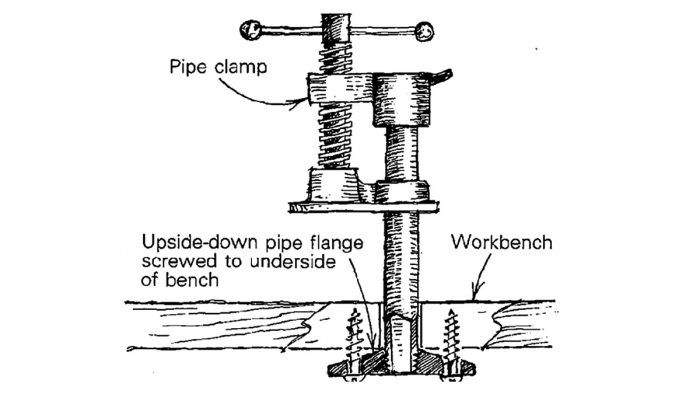
Whenever I need a hold-down clamp on my bench, I reach for one of my pipe clamps. As shown in the drawing, I insert a short length of pipe through a hole in the bench top. It is threaded into a pipe flange secured upside-down to the underside of the bench, giving me the versatility of a hold-down without having to buy one.
—Joseph Kaye, Uniondale, NY
Edited and illustrated by Charles Miller
From Fine Homebuilding #65
Fine Homebuilding Recommended Products
Fine Homebuilding receives a commission for items purchased through links on this site, including Amazon Associates and other affiliate advertising programs.

Affordable IR Camera

Reliable Crimp Connectors

8067 All-Weather Flashing Tape



























View Comments
Pipe damp or Pipe clamp?
Must be "pipe clamp". In the drawing the pipe flange is shown upside down. It seems to me it could be mounted with the flat side to the bottom of the bench, and still screwed into the flange through a hole. Otherwise, pretty clever system.
damp or clamp? Blame the scanning software (OCR)- it can have trouble distinguishing between cl and d- mix that with FHB's usual careful editing of Trip off the Doy and you can get some doofy headlines.
Ref "which side up" for the pipe flange, like most female pipe threads, their threads are typically tapered, narrow end at the flat side in this case, so if you want the threads to seat tightly, you have to go in from the contoured side.
Why not Just Bolt the End Clamp from the Adjustable end of a Pipe Clamp to the Underside of Your Workbench and Use a Pipe Clamp, W/O that end as Your Hold Down?
All you'd have to Do then is Use one Pipe Clamp and IF you aren't Using it as a Hold Down your Pipe wouldn't be Sticking Up through Your Workbench "To Get in Your Way"?
Damp or not, it made me look. There are a lot of nifty ideas/work arounds that pass through TOTD; aside from the nuisance of the contour the this may be among the best, as it doesn't take much time, effort or expense to affect. Hmm... where'd I put that pipe-damp.